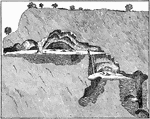Clipart tagged: ‘stone age’

Prehistoric People
In prehistoric times, a woman finds sleeping men from a different tribe and studies them.

Ratisbon
Regensburg, also Ratisbon, Ratisbona, is a city in Bavaria, Germany, located at the confluence of the…

Simonswald
Archaeological artifacts show that Simonswald was home to farmers as early as 6000 to 3000 BC. Roman…

Stone Celt
"Stone Celt (Neolithic), mounted in wooden haft, showing how these implements were used. The haft and…






